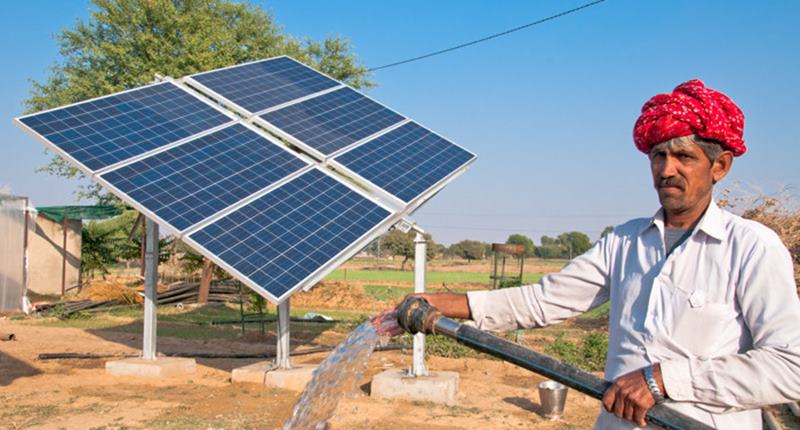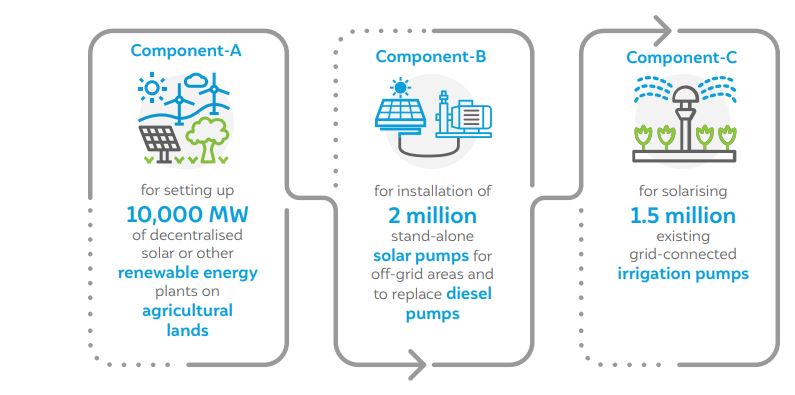Solar pumpsets gain some popularity amongst Rajasthan farmers but access to credit impeding PM Kusum scheme across India
The PM KUSUM scheme seeks to maximise the use of solar power by farmers by adopting solar pumpsets for irrigation. But a new CEEW study, based on discussions with stakeholders in several states, has cited challenges and suggested measures that can help the scheme in achieving optimum success. Details here.


Access to credit is a major factor that impedes the success of the PM KUSUM as most of the financial institutions demand collateral from the farmers.
Almost two years after the PM KUSUM (Pradhan Mantri Kisan Urja Suraksha evem Utthan Mahabhiyan) was launched to encourage farmers to install solar-powered pumping units in their fields, the scheme is facing several roadblocks. But in states like Rajasthan, some farmers have reaped several benefits.
This is one of the major findings of the recent study titled ‘Powering Agriculture in India – Strategies to Boost Components A and C Under PM-KUSUM Scheme’ conducted by New Delhi-based think-tank Council on Energy, Environment and Water (CEEW). And to highlight the challenges in the scheme and ways to address them, a webinar was organised today, August 26, with participants, including government officials, from various states.
“Notwithstanding the pandemic-related challenges, with almost half the scheme’s target period already over, these components have not taken off in most states. Only the Rajasthan government has offered letters of award for projects under Component-A,” notes the CEEW study.
Also Read: As India leaps to emerge a solar superpower, solar waste becomes a matter of concern

Component A is one of the three components of the PM KUSUM scheme which was launched by the Ministry of New and Renewable Energy in March 2o19 seeks to increase the share of solar power in India’s agriculture sector primarily by motivating farmers to install solar powered pumping kits for irrigation purposes. The scheme is divided into three components — A, B and C.
Component A entails about setting up 10,000 megawatts (MW) of decentralised solar or other renewable energy plants on agricultural lands. Component B is about installing two million stand-alone solar pumps for off-grid areas along with the replacement of the diesel pumps while component C is concerned with solarising 1.5 million existing grid-connected irrigation pumps.
Also Read: Energising rural India with reliable electricity supply

The CEEW’s recent study is focused on the components A and C, and is based on the interviews of 15 stakeholders from seven states to assess the state-level challenges for PM-KUSUM.
Solar pumpsets are changing lives
In the webinar, talking about the solar powered agriculture in Haryana, Hanif Qureshi, Director General of the state’s Renewable Energy Department, stated that although the state had launched solar power a couple of years before PM KUSUM, the central government’s scheme has increased the demand for solar powered pumps.
Also Read: Solar and wind energy projects in India need an impact assessment framework
“In Haryana, there are about six lakh (600,000) electric pumps for irrigation and three lakh (300,000) diesel powered-pumps. Although the demand for solar pumps is more from the diesel pump-operating farmers, a lot of large farmers who have bigger land holdings which cannot be irrigated by a single electricity pump are showing interest in the solar power,” Qureshi said.
Bipin Bihari, project director of JOHAR (Jharkhand Opportunities for Harnessing Rural Growth) stated that there have been challenges in introducing solar power in the agriculture fields but it has proven to be life-changing for the farmers in Jharkhand.
Also Read: Uttar Pradesh: CM Adityanath approves Rs 75 billion for solar projects with 1,535 MW capacity
“Some of the farmers cried in joy as they saw water being supplied to their fields by solar pumps. They said that they haven’t seen water being extracted from their field in almost 40 years,” said Bihari. “Earlier the farmers grew only rain-fed kharif (summer) crops but now they are cultivating crops like peas as well. So solar power can prove to be really beneficial where even conventional pumps have not reached,” the official added.
Need better access to credit
Meanwhile, sharing her experience of promoting solar energy amongst farmers, Rupali Thakur, a senior bureaucrat and chief executive officer (CEO) of the Himurja — a Himachal Pradesh government agency that aims at promoting renewable energy — pointed out that the solar energy is being used in the Himalayan state to increase farmers’ income as the state’s agricultural productivity is low.

“We deliberately kept the scheme small in Himachal Pradesh. It was between 250 kilowatt to 500 kilowatt because the operational land holdings are small. Eighty eight per cent of the farmers in the state are small and marginal farmers. And we got a good response from the farmers,” she said.
However, Thakur pointed out that access to credit is a major factor that impedes the success of the PM KUSUM as most of the financial institutions demand collateral from the farmers.
Also Read: ‘Green’ energy projects threaten to wipe off ancient ‘orans’ in Jaisalmer, Rajasthan

“So state subsidies can really help in making the scheme successful,” she said.
The recent study also mentions that state governments need to adopt innovative financing models like farmer-developer special purpose arrangements to address the financing challenges faced by the farmers.
The webinar also invited who has been a beneficiary of the scheme.
Also Read: Four months a year, solar pumps for irrigation remain idle in drought-hit parts of Maharashtra
“I used to get merely five to six hours of power in a day but now, due to the availability of solar power, I get twelve hours of power to irrigate my fields. My worries about erratic power supply are over and I advise my friends to set up the solar units in their fields,” Suraj Chaudhary, a farmer from Sanganer tehsil of Rajasthan, said during the webinar.
Key recommendations
For Component A
- The Ministry of New and Renewable Energy (MNRE) should consider extending the scheme’s timeline and converge it with the state-level power procurement planning cycle to enable discoms to effectively participate in the scheme.
- In consultation with the Forum of Regulators (FoR), MNRE should also prepare a framework for determining the tariff for distributed solar power plants, and consider rationalising the ISTS charges to create a level playing field for distributed power plants.
- The MNRE should also consider strengthening the compensation clauses for grid unavailability and payment default under PM-KUSUM to reduce the risks for developers.
- State governments need to adopt innovative financing models like farmer-developer special purpose vehicles to address the financing challenges faced by the farmers.
- State governments should also form a state-level steering committee to ensure inter-departmental coordination and smooth implementation of the PM-KUSUM.
For Component C
- Pilot the model in different agro-economic contexts to test its feasibility, identify viable financing structures, and study farmers’ behaviour concerning the use of surplus power.
- Discoms should lead the implementation as the component will throw up many challenges that only discoms can tackle. For instance, discoms need to identify and adopt solutions like smart meters and smart transformers to tackle challenges on the metering and billing front, while engaging with the farmers to build trust.
- The MNRE, in consultation with FoR, should prepare a standardised framework in determining a viable tariff for Component-C.

